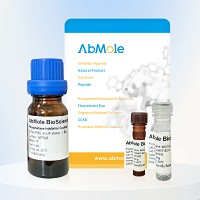All AbMole products are for research use only, cannot be used for human consumption.

Programmed cell death 1 ligand 1 (PD-L1) is also known as cluster of differentiation (CD274) or B7 homolog 1 (B7-H1), is a member of the growing B7 family of immune molecules and is involved in the regulation of cellular and humoral immune responses. PD-L1 is highly expressed in the heart, skeletal muscle, placenta and lung and weakly expressed in the thymus, spleen, kidney and liver. PD-L1 is expressed on activated T-cells, B-cells, dendritic cells, keratinocytes and monocytes. PD-L1 is up-regulated on T- and B-cells, dendritic cells, keratinocytes and monocytes after LPS and IFNG activation and up-regulated in B-cells activated by surface Ig cross-linking. PD-L1 involve in the costimulatory signal, essential for T-cell proliferation and production of IL10 and IFNG, in an IL2-dependent and a PDCD1-independent manner.
Accession: # Q9NZQ7-1
Apparent Molecular Weight: 31~35 kDa, on SDS-PAGE under reducing conditions.
Immobilized PD-L1, His, Human at 2.0 μg/ml (100 μl/well) can bind PD-1, Human.
Lyophilized from a 0.2 μm filtered solution in PBS, 5% trehalose and mannitol.
| Solubility (25°C) | Reconstitute the lyophilized powder in ddH2O or PBS to 100 μg/ml |
| Storage | Stable for up to 6 months at lower than -70°C |
[2] Qingqing Xiao, et al. Acta Pharm Sin B. Biological drug and drug delivery-mediated immunotherapy
| Related Cytokines and Growth Factors Products |
|---|
| Recombinant Human GDF-15 Protein (HEK293 N-hFc)
Growth-differentiation factor 15 (GDF15), also known as MIC-1, is a secreted member of the transforming growth factor (TGF)-β superfamily. GDF-15 has a role in regulating inflammatory and apoptotic pathways in injured tissues and during disease processes. GDF-15 overexpression arising from an expanded erythroid compartment contributes to iron overload in thalassemia syndromes by inhibiting hepcidin expression. |
| Recombinant Human FGFR1 Protein (HEK293, C-His)
FGFR1, also known as CD331, is a full-length representative protein consists of an extracellular region, composed of three immunoglobulin-like domains, a single hydrophobic membrane-spanning segment and a cytoplasmic tyrosine kinase domain. |
| Recombinant Human FGFR2 Protein (HEK293, C-His)
FGFR2, also known as CD332, acts as cell-surface receptor for fibroblast growth factors and plays an essential role in the regulation of cell proliferation, differentiation, migration and apoptosis, and in the regulation of embryonic development. FGFR2 plays an essential role in the regulation of osteoblast differentiation, proliferation and apoptosis, and is required for normal skeleton development. It also promotes cell proliferation in keratinocytes and imature osteoblasts, but promotes apoptosis in differentiated osteoblasts. |
| Recombinant Mouse BMP-4 Protein (E. coli, C-His)
Bone Morphogenetic Protein-4 (BMP-4) is a critical signaling molecule required for the early differentiation of the embryo and establishing of a dorsal-ventral axis. BMP-4 is secreted from the dorsal portion of the notochord, and it acts in concert with sonic hedgehog to establish a dorsal-ventral axis for the differentiation of later structures. |
| Recombinant Human Coagulation Factor X (HEK293, C-Fc)
Coagulation factor X, belongs to the peptidase S1 family. Coagulation factor X is initially synthesized in the liver. Coagulation factor X is a vitamin K-dependent glycoprotein that converts prothrombin to thrombin in the presence of factor Va, calcium and phospholipid during blood clotting. |
All AbMole products are for research use only, cannot be used for human consumption or veterinary use. We do not provide products or services to individuals. Please comply with the intended use and do not use AbMole products for any other purpose.


Products are for research use only. Not for human use. We do not sell to patients.
© Copyright 2010-2024 AbMole BioScience. All Rights Reserved.
